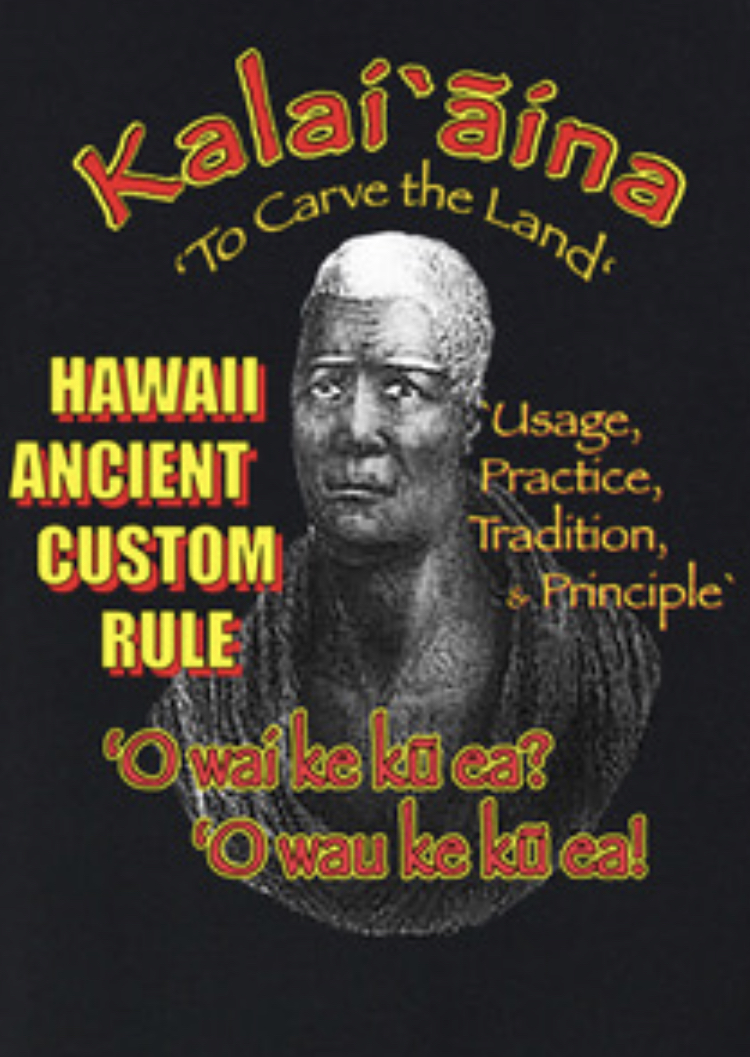
Part I. Enlightenment. Ancient Hawaiʻi(an) Custom Usage called Kālaiʻāina.
*Be sure to sign Our Kūleana form at the bottom

1. Hawaii Ancient Kuleana (“land”) Held in Fee (“Hoʻokupu”) system.
Hawaii’s ancient Kuleana “land (held) in fee” Hoʻokupu system was remarkably similar to that of the European feudal land system with exceptions. The feudal system is a land (holden) in fee system that is based on a hierarchy. At the head was a military chieftain or a king (“lord paramount”) and their followers – (warrior chiefs), nobles (superior lords), knights or vassals. Their relation was determined by the bond established by a grant (gift) of land from the former to the latter. Those that received land (called feud, fee, fief or feudum) had only the right to use the land and not own the land on condition that the tenant shall render fealty, military duty and other feudal “land in fee” services to the Lord paramount “king”.
Hawaiiʻs ancient Kuleana Hoʻokupu “land (held) in fee” system was also structured as a hierarchy. At the top was the Aliʻi akua (Divine/Heavenly One “Mōʻī”.) As the direct descendant of Akua (“god”), he is the spiritual Konohiki (caretaker) over all the lands for Akua. As the secular Mōʻī (“king”) he is the undisputed sole owner of all the land in his kingdom. He is the ‘sovereign over all the people and all the chiefs and the kingdom is his.’ To consolidate his ownership of the land the Mōʻī has the god given power to execute the ancient custom usage called Kālaiʻāina (to carve) and distribute the land to his followers – Aliʻi Nui (principal/superior warrior chief) Aliʻi Liʻiliʻi (lessor chief), Konohiki (caretaker) and favorite. These followers were only land holders and never land owners. They recieved land from the Mōʻī on condition that they owe and pay the Kuleana Hoʻokupu (“land in fee”) services (labor and military duty), tribute (the yearly and the land and sea taxes), duty (fealty and loyalty) and incidents (forfeiture and reversion) at all all times. Failure to owe or pay the land in fee was just cause to have the land forfeited and reverted (“reversion”) back to the Mōʻī.
2. Hawaiʻi ancient custom usage called Kālaiʻāina
The Kālaiʻāina is the core element of Hawaiʻi ancient land (held) in fee system. As the sole owner of all the lands, his duty was to summon all the “landholders” – the Aliʻi nui (principal warrior and superior chiefs), Aliʻi liʻiliʻi (lesser chiefs), Konohoki (caretakers) and favorites – to attend his Kālaiʻāina. The second step was the Hoʻihoʻi – another ancient custom – that demanded the return of the lands held by the landholders – who had received lands from their prior Mōʻī. The Kalaimoku (the divider) was appointed by the Mōʻī to prepare and implement his Kālaiʻāina.
3. The Execution of the Kālaiʻāina
The Kālaiʻāina began when the Mōʻī selected lands for himself, his retainers and attendants – who cultivated and managed his lands. The next class to receive lands from the Mōʻī was the Aliʻi Nui (principal warrior and superior chiefs) who were his staunch supporters. The class after the Aliʻi Nui was the Aliʻi Liʻilʻili (lesser chiefs) that were followed by the Konohiki and then the Mōʻī favorites. After the Mōʻī completed his Kālaiʻāina, all the lands in his kingdom were carved out, distributed and accounted for. Every landholder that received land from the Mōʻī Kālaiʻāina were obligated to owe and pay the Hoʻokupu Kuleana “land in fee” services to the Mōʻī as the “lord of the fee.”
4. Ancient Hoʻokupu Kuleana “land (held) in fee” system process

After the Mōʻī completed his Kālaiʻāina it was his principal warrior and superior chief’s (Aliʻi Nui) who had the greater obligation, responsibility and duty. Their obligation to the Mōʻī was: (1) to build and maintain the Mōʻī military, (2) to increase the wealth of the Mōʻī (3) to increase the economic prosperity of the kingdom, and (4) to increase their own welfare. To accomplish these obligations, each Aliʻi Nui would divide the lands he received from the Mōʻī amongst his lesser chiefs. Each lesser chief who recieved land from his Aliʻi Nui was obligated to owe and pay the “land in fee” to their Aliʻi nui. Then the lessor chiefs divided the land they received to his konohiki who had the responsibility of fulfilling the land in fee services. This Hoʻokupu Kuleana “land in fee” system continued downward until all the land was subdivided down to the commoners who tilled the lands.
The same obligation, responsibility and duty also applied to the Aliʻi Nui was also applied to the Aliʻi Liʻilʻi, Konohiki and favorites who received lands directly from the Mōʻī Kālaiʻāina. They divided their lands among their followers on the same condition that everyone owe and pay the land in fee services, tribute, duty and incident directly to the Mōʻī as the “lord of the fee.”
According to ancient land custom failure to fulfill any of the land in fee services, tribute, duty and incidents was just cause to forfeit the land and revert the land back to the Mōʻī or the above lord. All landholders were tenants at the will of the Mōʻī. Upon the death of a landholder the Mōʻī had the power to take the land back and assign the land to another landholder. These were a few ancient customs that were the cornerstones and perpetual laws of Hawaiʻi’s governing land system.
5. Mōʻī “King” Kamehameha I. Executes His Kālaiʻāina

“When the islands were conquered by Kamehameha I, he followed the example of his predecessors, [he Kālaiʻāina (carved out)] and divided the lands among his principal warrior chiefs [Alii Nui] retaining however, a portion of his lands, to be cultivated and managed by his own immediate servants or attendants…. All persons
landed property, whether superior landlords, tenants and subtenants, owed and paid to the King [Mōʻī] not only a land tax… but also services which were called for at discretion, on all grades from the highest down. They also paid some portion of the productions of the land [and sea] in addition to the yearly [Makahiki] taxes. They owed obedience [loyalty] at all times. All these were rendered not only by natives, but also by foreigners who received lands from Kamehameha I. and Kamehameha II., and [Kamehameha III.]. And failure to render any of these [services] has always been considered a just cause to forfeit the lands [back to the Mōʻī as his reversion right].”
Summary:
Hawaii’s ancient Hoʻokupu Kuleana “land (held) in fee” system was structured under the strict maxim and principle “that the Alii Akua / Mo’i “is the sovereign over all the chiefs and people, and the kingdom is his” and he is the undisputed sole owner of all the lands in his kingdom.”
